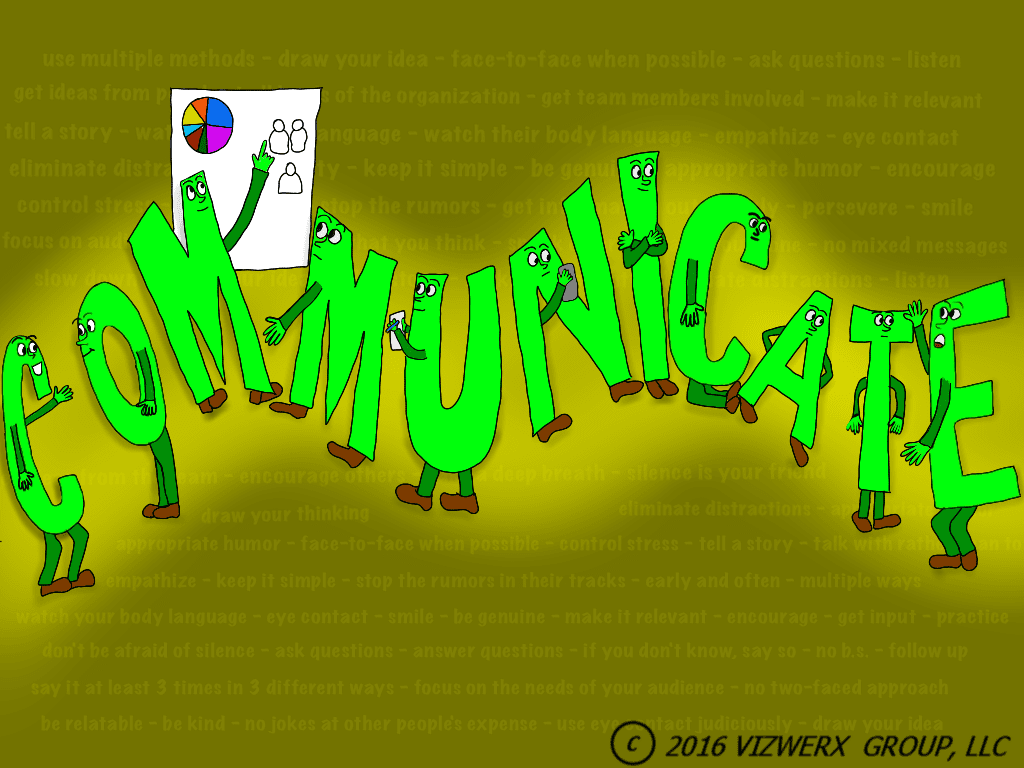- Welcome back to the Let’s Grow Leaders Frontline Festival. This month’s festival is all about communication tips. Thanks to Joy and Tom Guthrie of Vizwerx Group for the great pic and to all our contributors! Next month’s Frontline Festival is all about having fun with your team. Submit your ideas here!
Often when the word “communication” is brought up, we think of what we are going to say. Listening is a form of communication too, and almost everyone can listen more. This post by Mary Jo Asmus of Aspire Collaborative Services describes the times that you might need to really listen. Follow Mary Jo.
Chip Bell of the Chip Bell Group suggests that we improve business communications by having the same business hours as Amazon. That means always being accessible except when you physically cannot (like you are on a flight or in the middle of keynote). Otherwise, make it super easy for your customers to reach you. How many websites do you access that fail to provide a direct phone number but instead require you to fill out a dang form to communicate with the owner of the site? Connection should always trump self-serving (i.e. building a database) marketing. Follow Chip.
Beth Beutler of H.O.P.E. Unlimited gives us five ways to fight communication overload. Follow Beth.
Wally Bock of Three Star Leadership suggests we read this if the thought of giving a speech makes you break out in a cold sweat or feel like you’re going to throw up. Follow Wally.
When the Challenger Space Shuttle exploded, there was an in-depth investigation to determine the cause. One of the top three reasons cited for the accident was a breakdown in communications among the involved project workers. Michelle Cubas, CPCC, ACC, of Positive Potentials, LLC invites us to consider how communications unravel in offices and between departments when strangers are involved that did not work together like the Challenger team. Follow Michelle.
Wise men speak because they have something to say; Fools because they have to say something.
~ Plato
Eric Dingler of EricDingler.com sees two big mistakes in business communications and both cost nothing to fix. He suggests to first change our email signatures. People don’t need a hyperlink to our email address or even social media profiles–they need to go to our websites where all that information (and more!) is available. Second, keep our email inboxes at zero. It’s bad form to not get around to replying to someone because “It got lost in your never-ending flood of emails.” Either respond, or move it to a task list, scheduling a time to deal with it. Follow Eric.
David Dye of Trailblaze says “The single best business communication tool I can recommend is to check for understanding. Communication is a loop – there should always be a send and receive. Don’t just ask ‘Do you have questions?’ Say, ‘Let’s make sure we’re on the same page’ and listen to their version to ensure it’s the same as what you think you said.” Follow David.
Chris Edmonds of Driving Results through Culture reminds us that one of the biggest opportunities leaders have in business communications is to link projects, goals, and tasks to strategy and then communicate that strategy, refine that strategy, and help team members link their goals and tasks to that strategy. Follow Chris.
David Grossman of The Grossman Group David says that asking questions and listening are critical. Before you can understand a business problem or achieve a goal, you have to understand what the situation is., and questions are the best way to come at a problem. Follow David.
We have two ears and one mouth so that we can listen twice as much as we speak.
~ Epictetus
John Hunter of Curious Cat Management Improvement advises that making communication explicit creates a process that is less likely to result in problems that stem from communication failures. Follow John.
Lisa Kohn from Thoughtful Leaders Blog encourages us to do our best to learn and understand the needs and perspectives of the person we’re communicating with, and be very clear what your intentions are for the communication, because misunderstanding happen to everyone. Follow Lisa.
Jon Mertz of Thin Difference reminds us that organizational leaders must communicate with teams by embracing the teacher-professor mindset. It’s a truly effective way to embrace, engage, and activate the next generation. Follow Jon
Shelley Row of Shelley Row Associates encourages us not to be THAT person–the one who sends flaming emails. Follow Shelley
The most important thing in communication is hearing what isn’t said.
~ Peter Drucker
Writer Riya Sander observes that from power dynamics to scheduling to competition for promotions and perks, there is a certain amount of conflict that is difficult to avoid in the modern workplace. She feels leadership development is about becoming a great group leader who gets the best work from a group of stars by using coaching skills to encourage an atmosphere of collective problem-solving and cooperative achievement. Follow Riya
William Steiner of Executive Coaching Concepts gives three communication tips: Listen well and listen 80% of the time, asking clarifying questions; find time to meet others in person to really build a relationship; surprise and delight others with a handwritten thank you note. Follow William.
Linda Fisher Thornton of Leading in Context suggests that we talk about what matters: things people find difficult to deal with, tough questions and areas where leadership needs to improve. Follow Linda.
Bad human communication leaves us less room to grow.
~ Rowan Williams
Reminder: Next month’s Frontline Festival is all about having fun with your team. Submit your ideas here!







0 Comments